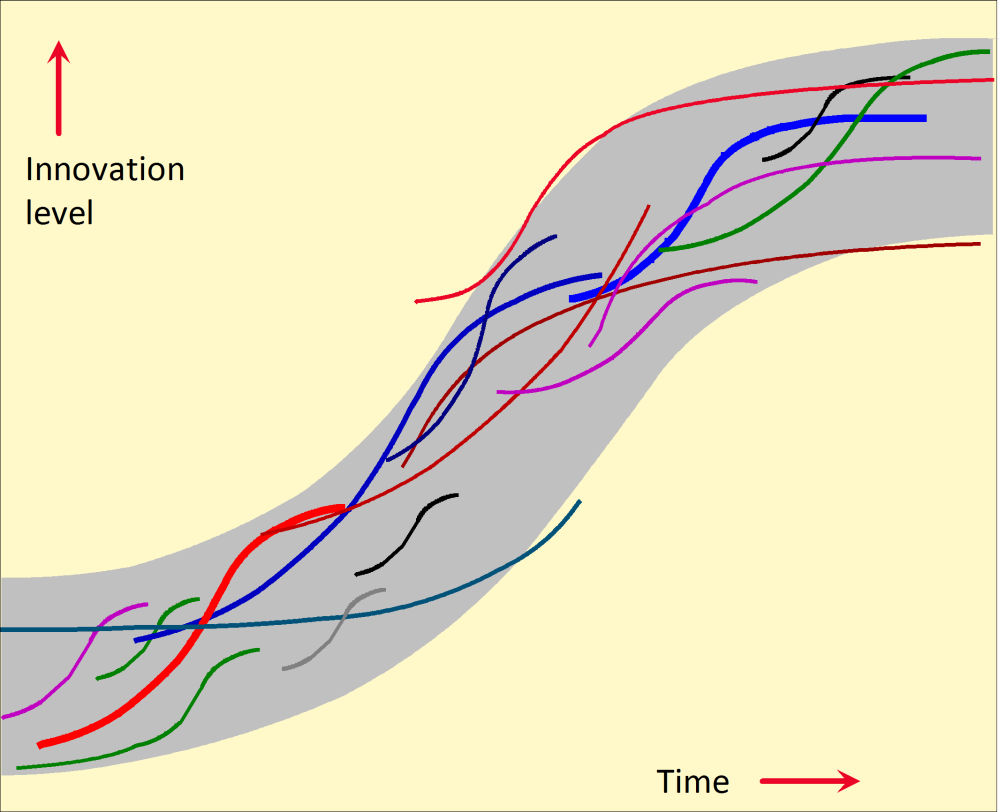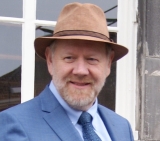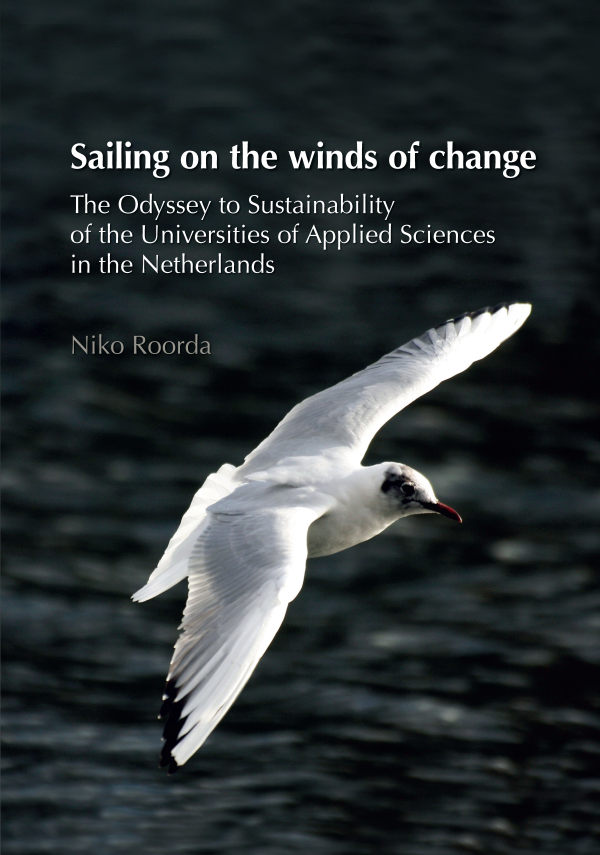PhD Thesis: Sailing on the Winds of Change < Previous page Next page >
The Odyssey to Sustainability of the Universities of Applied Sciences in the Netherlands (2010)
This book can be downloaded free of charge.
Maastricht University Press ISBN 978-9052789804 Table 6: Characteristics of Education for SD Some illustrations in the book In 2010, Roorda completed a scientific research that had lasted for nearly 20 years, being a chain of practical investigations into Education for Sustainable Development (ESD). The results were written down in Roorda's dissertation, based on which he received the title of 'doctor' (PhD) at Maastricht University in the Netherlands. The dissertation can be downloaded from here. Important aspects of the PhD Research were e.g.: SD relations between Education and Society Characterization of ESD (see e.g. 'Table 6', below) Action research: Development of a BSc program majoring in SD Embedding SD into existing education (report) AISHE: Assessment & Certification of ESD RESFIA+D: Competences for SD |
Download the Thesis (2010) |
Sustainable development cannot be thought away anymore from society. It has become a major process giving shape to the future of mankind and of our planet. Education has to contribute to this process in a major way, as it builds this future as no other sector of society. The central question of ‘Education for Sustainable Development’ (ESD) is: “Which strategies can be used in order to make education contribute effectively to sustainable development?” The PhD study is an attempt to discover fruitful strategies for ESD.
In the course of the dissertation, a hypothesis will be tested, stating that a successful strategy is one of ‘sailing on the winds of change’, i.e. following and using change processes that are already occurring in higher education, on condition that such change processes do occur, and are heading in a suitable direction.
In the last decades, the subject of ESD has become a new field of scientific study, which is described in Chapter 1. It makes use of recently developed or improved methods and paradigms of science like case study research, action research, mode-2 science, postnormal science and transdisciplinary research. Together they form the fundament for the research that is presented in the dissertation. An important principle of case studies is that of ‘triangulation’, which enables the researcher to combine empirical information from different kinds of sources. This principle will be used intensively.
The research was indeed an action research, performed as a chain of case studies that took place between 1991 and 2009. All of them followed the above strategy of ‘sailing on the winds of change’. Some of them were more successful than others. In order to understand the successes and failures, several theoretical models are used that describe change processes. The main models for this research are: a model by Sterling for the level of change; a model by De Caluwé & Vermaak for the types of change processes; and a model by Bridges describing the natural development of organizations.
Chapter 2 describes the concept of sustainable development, defining and describing it in a way that is sufficient for the purposes of the present research. The impact of education on sustainable development is discussed, both on a global scale, including the United Nations Decade of Education for Sustainable Development (DESD), and in the Netherlands, including the Dutch national strategy for sustainable development. The inverse, i.e. the impact of sustainable development on education, is studied in some detail, as this impact is essential for the research presented in the dissertation. Several sources in the literature are consulted, among which Agenda 21 and a series of publications by ESD investigators, which leads to an overview of characteristics that are typical for education that effectively contributes to sustainable development. This overview is used throughout the dissertation as a checklist in order to assess a main aspect of the several experiments.
Chapter 3 is dedicated to the selection of the field of study. This is the sector of HBO (‘Hoger Beroepsonderwijs’), the sector of Dutch Universities of Applied Sciences, which forms about two thirds of all of higher education in the Netherlands. In the last two decades, the same period in which the chain of experiments of the present study took place, this sector has gone through a series of intense change processes. These processes are described briefly in chapter 3, as they will be described in more detail in the later chapters.
Next, chapter 3 describes the experiments that were performed. Five of them have been completed, each lasting on average about four years. Three more experiments started only a few years ago, and they are not yet finished.
The chapter ends with a description of the way in which the results of each of the experiments is systematically assessed. A series of success criteria is developed that is used for all experiments, and it is proved that these criteria together meet the demands of validity that the applied type of research requires.
The next five chapters each are dedicated to one of the completed experiments. They all have the same structure. In the first of them, Chapter 4, first the context is described in which it took place, i.e. the change processes within HBO that occurred at that time, e.g. a wave of mergers between HBO institutions, and an avalanche of new study programs. In this context, a suitable ESD strategy was followed between 1991 and 1994, i.e. the development of an entirely new study program dedicated to sustainable technology in a University of Applied Sciences in the south of the Netherlands. Its philosophy, its development and the resulting curriculum are described in the second part of chapter 4, followed by an assessment of the results, which finally leads to a conclusion about the strengths and weaknesses of the used ESD strategy.
The second experiment took place in a context in which a range of new educational methodologies made its entrance in HBO, e.g. problem-based learning and project education. The focus of the second strategy, described in Chapter 5, is the application of such methodologies for the purposes of ESD. For this goal, the study program that was described in chapter 4 was redesigned between 1994 and 1998, trying to realize goals like: more active attitudes of the students, and a more multidisciplinary curriculum. Again, after a description of the context and the redevelopment of this study program, the results are assessed, and conclusions are drawn about the effectiveness of the followed strategy.
Chapter 6 describes an experiment in which an attempt is made to integrate sustainable development within the 13 study programs of a Faculty of Technology, most of which paid no or hardly any attention to sustainability-related aspects until then. This was an ESD strategy that made sense at that time, 1998 – 2002, as efforts were made to restructure HBO and decrease the number of study programs, in order to improve the clarity and the quality. The Cirrus Project was supported by a range of companies, national and local government organizations, ngo’s, and by the HBO Council, i.e. the association of HBO institutions. Just as the former chapters, the successes and failures of the experiment are assessed using the management theories described in chapter 1.
In Chapter 7 the development is described of an instrument to assess the rate of success of the integration of sustainable development into the curriculum of study programs, in a quality management style. The instrument, AISHE, was developed in 2000 – 2001. Between 2002 and the present, it was applied through a consultancy offered to the Dutch universities by DHO, the Dutch Foundation for Sustainability in Higher Education. Based on AISHE assessments, a Certificate of Sustainability in Higher Education is awarded to successful study programs or university departments. The policies and methods of this consultancy are described and assessed. A fundamental principle, ‘system integration of sustainable development’ (SISD) is defined and made operational, after which case studies are used to prove that SISD is achievable, and indeed has been achieved.
The experiment of Chapter 8 took place in a context in which HBO was part of an internationalizing higher education, e.g. the Bologna process, with more and more flexible learning routes, and with an increasing role of ICT. As investigation showed a need for educational materials about sustainable development, a strategy was followed in which an instrument was developed for the introduction of sustainable development, both for teachers and for students. The core of the instrument is a study book called ‘Basic Book on Sustainable Development’, which was published in 2006. Besides, a range of other tools have been developed, all available through a website. The SD introduction instrument has been applied between 2006 and the present in HBO institutions, and the extent to which it satisfied the needs of teachers and students is assessed.
Chapter 9 describes the three experiments that were still being performed when the dissertation was completed. The structure of this chapter differs from the earlier ones, as no result assessment is yet possible, and so no conclusions are drawn.
Again, first a description is given of the context, i.e. of a relevant change process. In this case, this was the introduction of competence based education.
The first of the three unfinished experiments concerns the design of an instrument for the development or improvement of the competence profile of a study program from a sustainability perspective. The ‘SD Competence Cards’ are based on a model for sustainability competences called RESFIA+D, which is described in a book that was developed for this goal.
The second current experiment focuses on the curriculum contents. The SD Curriculum Scan is used by educational developers to compare a curriculum with a list of themes and subjects, enabling them to discover strengths, weaknesses and ‘white spots’ related to sustainable development.
The final current experiment describes the redevelopment of the AISHE assessment instrument, this time by an international team. The aim is to expand the field of investigation of AISHE, which in its first version focused on the educational role of a university, to the other roles: research, operations, and community activities.
In the final Chapter 10, all lines come together. The first section has an analytical character, as the various experiments are compared, trying to draw some general conclusions about why certain strategies were successful and others were less so.
The second section brings a full synthesis of all results, based on a ‘grand triangulation’. Here the conclusion is drawn that each of the development processes in HBO in the last twenty years, when taken separately, were no more than an accommodation or a reformation process; but nevertheless, together they form a coherent and deep transformation of higher education. However, until system integration of sustainable development (SISD) is realized throughout HBO, this transformation will be incomplete.
Based on the conclusions about whether or not the various applied strategies of the PhD research were successful, the final question will be answered with the conclusion that the basic principle behind all experiments, ‘sailing on the winds of change’, was indeed proved to be successful.
Table 6: Characteristics of Education for Sustainable Development
Table 6 in chapter 2 offers an important overview of the essentials characteristics of education that is effectively able to contribute to sustainable development. The table can be applied as a checklist for existing or newly to be designed education programs.
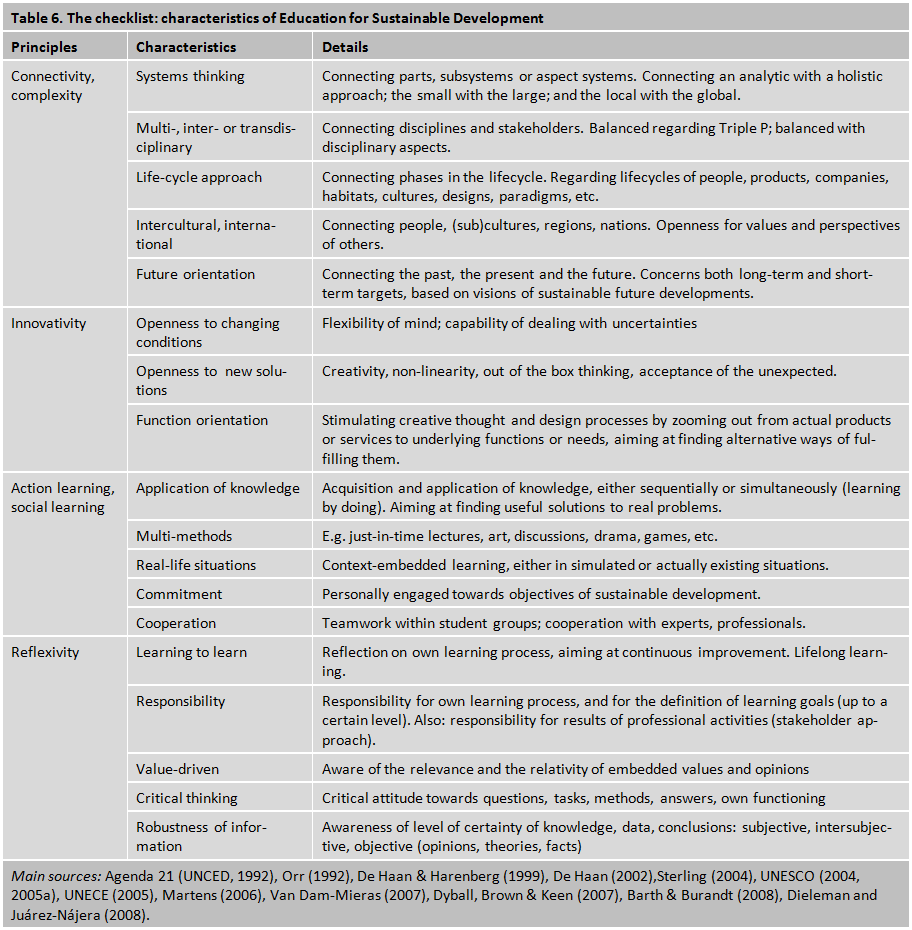
Some illustrations in the book
Here follows a selection of images that are printed in the dissertation.
Chapter 1: the four-payer model of education
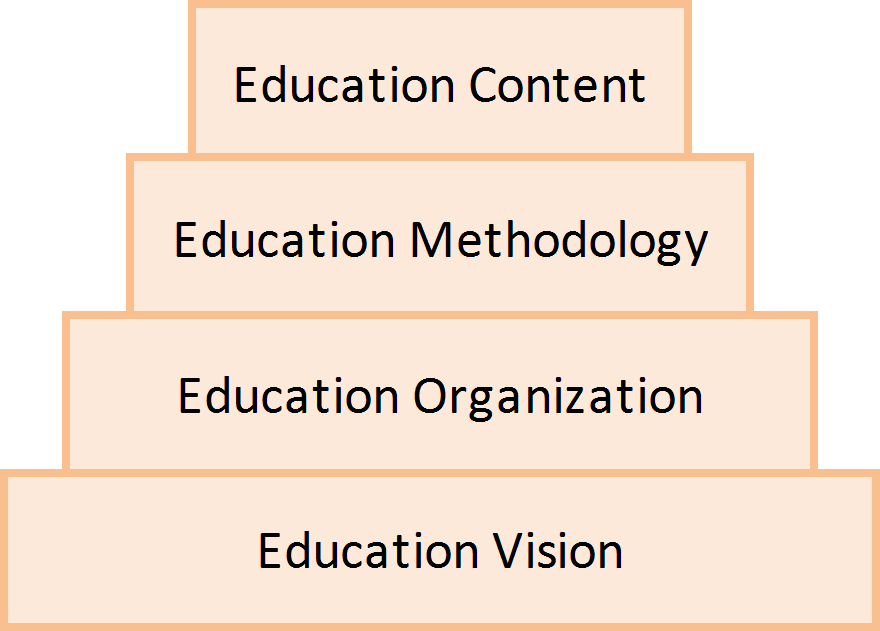
Chapter 4: Various ways to combine disciplines in an education program
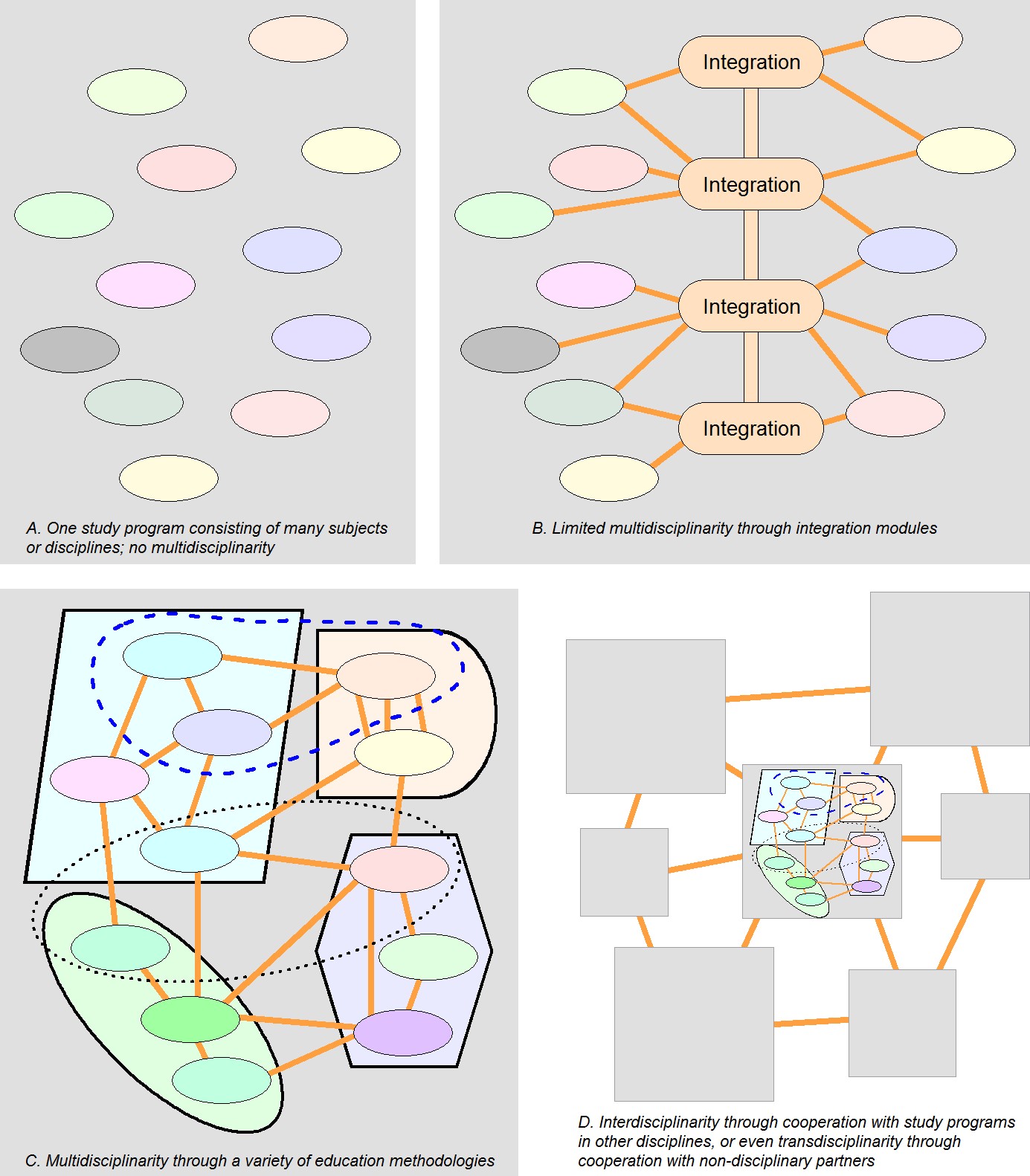
Chapter 10: The Transformation Map of the Dutch Universities of Applied Sciences, 1990 - 2010, including the input from the experiments described in this dissertation
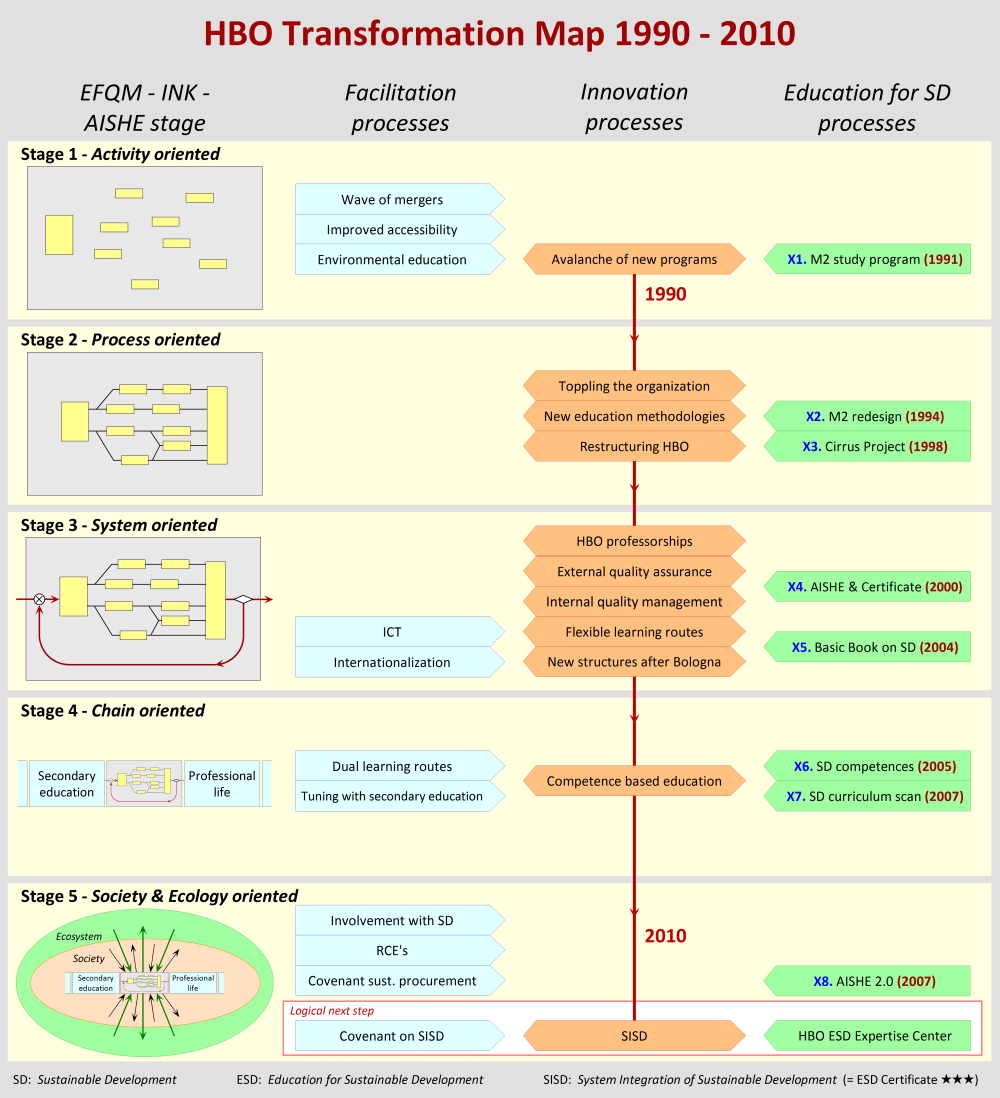
Chapter 10: Several iterative processes in the development of the Dutch Universities of Applied Sciences
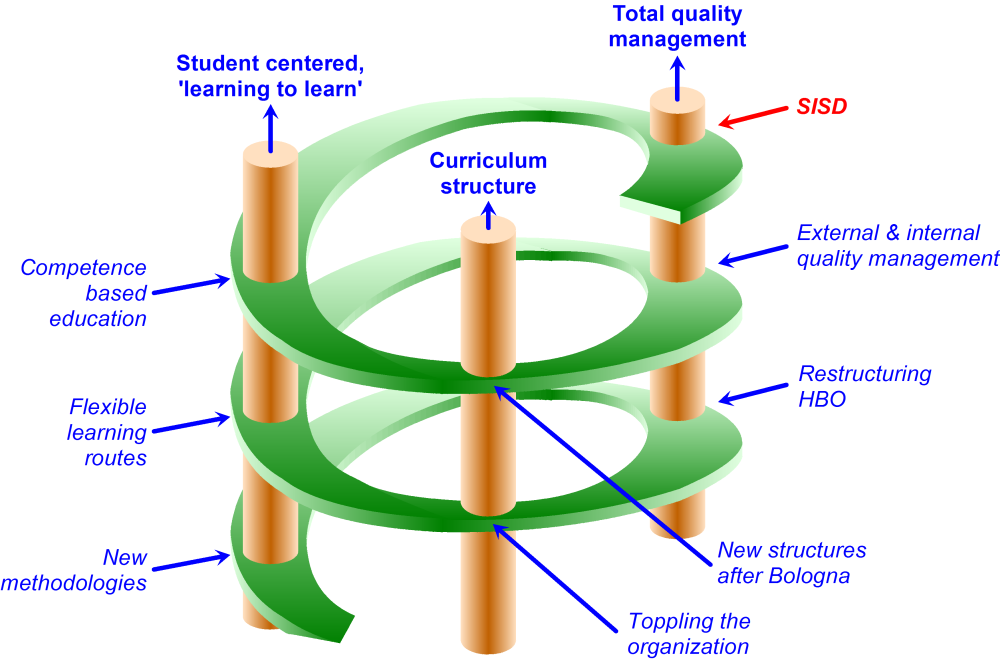
Chapter 10: A long series of accommodations and reformations results in a transformation
